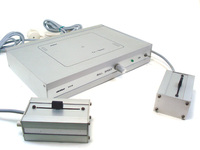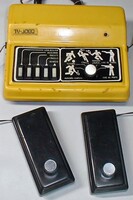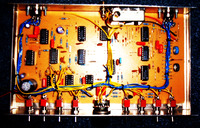National Semiconductor Adversary
 1976
1976 

The story is far from finished. If GI released the AY-3-8500 in 1976, the competition was already present.
National Semiconductor (NS) released their chip integrating three Ball & Paddle games: the MM-57100N (also released as the MM-57105N in PAL format). NS advertised the chip as playing games with true and realistic colors (the background was green for Tennis, blue for Hockey, and magenta for Squash). This major feature probably boosted the sales. As a matter of fact, the basic configuration of the GI AY-3-8500, 8550 and 8600 chips delivered a black and white picture, and another GI chip was required to produce color pictures, hence a higher cost. The MM-57100N chip and its PAL equivalent only required two interfacing chips: the MM-53104N clock driver and the LM1889N color modulator. As the LM1889N was cheaper than GIs color encoders and widely available, every system designed with the NS chips played game in colors, as opposed to many systems built with GI chips.
The NS games also differed from the GI games. For instance, each player appeared alternatively in the Squash game when the ball was hit, and the Hockey game showed six square opponents (organised in two groups of three) moving up and down on the screen. The sound was directly sent to the TV set instead of coming from a speaker in the system. The game selection only required a push-button instead of a switch (rotary or linear) which could fail after many game selections. The scores appeared once a player lost the ball, the bats could have three different sizes, and the ball accelerated once it bounced four times on the players. Finally, the games could also be played in solo: the single player controlled both sides of the games using the same controller.
For the release of this new chip, NS launched a small system called National Adversary (model 370). Although not very nice, it played the three games of the chip and sold pretty well. The same system was sold in semi-kit form by Heathkit as Model GD-1999 (the circuit board was already assembled). The only problem was the competitive price of the AY-3-8500 and also its wide reputation as most manufacturers used it.
Although NS had a pretty smart idea by releasing the MM-57100N chip, the increasing success of GI became too high for NS, and facing the situation became more and more difficult. As an attempt to survive this situation, NS released another chip in 1978: the MM-57106N (also known as MM-57186N in PAL format). This one played six different games: those of the MM-57100N, plus Wipe-Out (Breakout clone), Flipper and Football. Each game was playable in several variants, giving a total of twenty-three games. This chip was not successful and the only systems known to use it are the Philips N30 (and its equivalents sold under the Radiola and Schneider brands) and the Philips Odyssey 2100, both released in Europe. NS advertised an improved Adversary system (model 600) based on this chip, but no specimen surfaced yet.
Modelo 370
uP 8046
uP 8046

 video games gallery from the last century
video games gallery from the last century



































